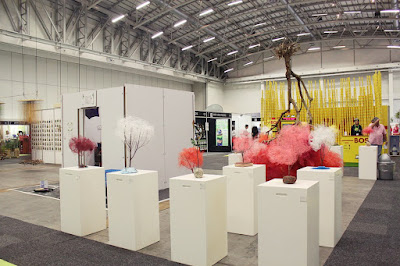[Issued by MANGO-OMC on behalf of Shift]
Prototypes of the winning designs of the 2011-2012 Fresh Talent competition, hosted by the then known
Eco Design Initiative (which in August rebranded to
Shift: Inspiring sustainable design) will be
on show at The Hub in Johannesburg from 14 November. The exhibition marks the final leg of the past year’s competition and coincides with Global Entrepreneurship week, an international initiative that introduces the act and art of
entrepreneurship to young people in various countries.
The exhibition will run from 14-24 November and entry is free.
Says Janine Johnston, CEO of Shift:
“We are very excited to launch the Johannesburg exhibition of the 2011-2012 competition on this date as one of our aims is to not only teach young creatives to design sustainably but also to think in an entrepreneurial way when designing. After all, sustainable design aims to deliver social, environmental and economic benefits.”
The annual Fresh Talent competition invites young people to design sustainable solutions for a range of challenges faced by people and the environment. Showcasing the designs and concept prototypes of the 2011-2012 winners and multi-media stories of the finalists’ journey into sustainable design through their participation in Shift’s educational exchange program, the exhibition also offers the opportunity to view global examples of sustainable design curated with
INDEX:
Design to Improve Life®.
The winners of the 2011-2012 Fresh Talent Competition are:
Gabriele Birkenmayer for Shoots –A Grassroots Bamboo Project (first place)
Shoots – a grassroots bamboo project
“Shoots” is a full-cycle approach to sustainability that produces well-designed, good quality consumer products, furniture in particular, while addressing unemployment in South Africa and caring for the environment.
Shoots aims to involve rural communities in the planting and farming of bamboo in areas that require rehabilitation, such as those affected by soil erosion or water pollution. Bamboo is known to enrich and stabilise soil due to its root system that soaks up heavy metals and aids in water purification. Bamboo is also a highly sustainable plant, reaching maturity in 5 – 6 years and since it is a grass and not a tree, harvesting bamboo does not kill the plant. A bamboo ‘clump’ can be selectively harvested annually for over 100 years. Bamboo also produces up to 30% more oxygen than any other tree, making it not only a sustainable material, but also very environmentally friendly.
The rural communities responsible for growing these ‘plantations’ will be trained in harvesting the plants, converting it into laminated or strand woven boards and how to convert these boards into self-assemble furniture which will ‘last a lifetime’ – in terms of both material durability and non-conformity to any fashion trends.
Wayde Dyers for his Vermiculture Growth System (second place)
Vermiculture Growth System
The Vermiculture Growth System is a compact composting and rain harvesting system utilizes the benefits of worms – nature’s own recyclers, to convert food waste into nutrient rich, 100% organic fertilizer while harnessing the benefits of rain water to feed plants in home, vegetable and potted gardens.
The Vermiculture Growth System is easy to use and versatile. The unit, which is compact enough to fit on a balcony, in a shed or shaded outdoor location, is made from 70% recycled plastic.
The Vermiculture Growth System consists of five trays and a water catchment. The composting worms, Red Wigglers, start off in the first working tray and they simply eat their way up, “wriggling” into the working trays above, where they can detect the food scraps. Along the way, the worms produce castings (manure) - also known as “black gold”; trays of which can be removed, diluted and hydrated using the water collected in the system’s rain harvester for plant nourishment.
The cycle is never ending.
Marieke Adams for the Ikghuphu Sleeve (third place)
Ikghuphu Sleeve
Ikghuphu is a series of laptop sleeves made from wet suite factory waste. It draws inspiration from the Ndebele’s abstract patterns decorating clay walls, translating the colours and patterns into a multi-dimensional textile that provides tactile interest and additional protective cushioning for the product inside.
Made using neoprene offcuts –factory waste, and traditional hand crafting techniques this design combines influences of traditional and contemporary homes, in both function and material.
The traditional stitch and craft techniques used in the production of Ikghuphu Sleeves create more opportunities for skills development, job creation and economic empowerment, especially for women. Using “waste” materials reduces the environmental impact and significantly reduces the material costs of production.
The Ikghuphu Sleeve is a sustainable design that appeals to the global contemporary market of laptop users and improves opportunities for sustainable development.
The Exhibition is free and open daily from 9am to 9pm at The Hub, 4 De Beer St (cnr Smit St), Braamfontein, Johannesburg, 2000.











.JPG)














